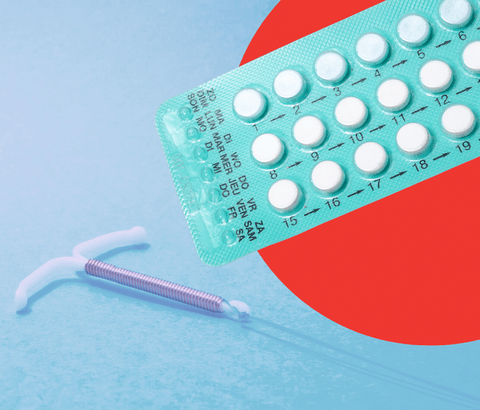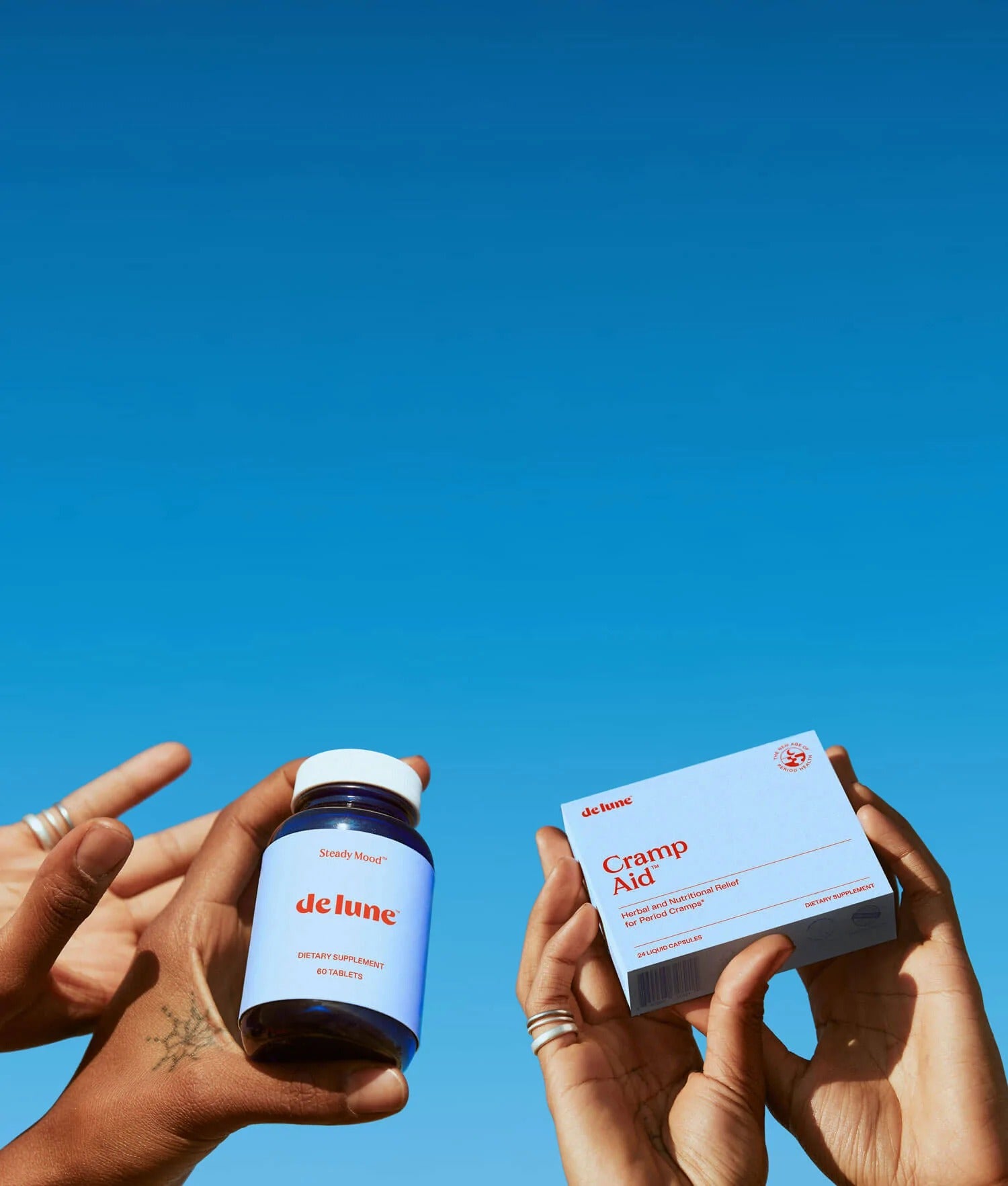Premenstrual syndrome (PMS) is combination of physical and emotional symptoms that many people get about a week or so before their period.1 Common symptoms include irritability, sadness, bloating, and headaches, though the full list of possible symptoms is lengthy.2
Over 90% of people with periods experience PMS.3 For some, PMS is very mild or not noticeable. For others, PMS is severe and interferes with daily activities, like going to work or school.
While researchers don’t know exactly what causes PMS, they think it may have something to do with a disruption in neurotransmitters that regulate mood.1 Vitamin B6, which is involved in the production of these neurotransmitters, may offer relief.
Why Vitamin B6 Matters
Vitamin B6 is a versatile vitamin that’s involved in more than 100 enzyme reactions. It not only helps produce neurotransmitters,4 it also performs other important tasks like regulating how hormones work,5 bolstering immune functions,6 and playing a pivotal role in metabolism.7 B6 also keeps homocysteine levels in check; without it, too much homocysteine would cause inflammation.8
Vitamin B6 is actually the generic name for a group of compounds:
- pyridoxine
- pyridoxal
- pyridoxamine
- pyridoxal 5’ phosphate (PLP)
- pyridoxamine 5’ phosphate (PMP)
Chemically, each of these looks a bit different and performs a bit differently in the body. PLP and PMP are the ‘active’ forms of B6—that is, the body doesn’t need to chemically change these forms before it’s ready to use them.9

Can Vitamin B6 Fight PMS Symptoms?
Researchers think vitamin B6 relieves PMS symptoms for two reasons:
- B6 helps make "happy neurotransmitters" like serotonin and dopamine.
- B6 helps make a certain kind of prostaglandin (a type of chemical messanger) that tends to be low in people with PMS.
B6 & Happy Neurotransmitters
Vitamin B6 is a cofactor in neurotransmitter biosynthesis. Neurotransmitters are chemical messengers in the brain that regulate mood and feelings of well-being. B6 has the unique ability to increase amounts of the neurotransmitters dopamine and serotonin in the brain.10 Dopamine regulates motivation, cognition, and pleasure.11,12 Serotonin regulates mood, appetite, sleep, memory, and sexual desire.
Not surprisingly, low levels of serotonin are associated with depression.13 Not getting enough B6 to make these 'happy neurotransmitters' may exacerbate mood-related PMS symptoms like sadness, stress, and loss of sexual desire.
Moreover, some researchers believe that low B6 levels may cause extra bloating. A vitamin B6 deficiency can cause dopamine levels in the kidneys to plummet. This causes the kidneys to pump out sodium, which in turn, causes water to accumulate throughout the body.10
B6 & Prostaglandins
It's also possible that incorrect prostaglandin synthesis worsens PMS symptoms. Prostaglandins are tiny compounds that have hormone-like effects on the body. There are many types of prostaglandins, some that cause period pain, and others that reduce it.
Researchers have proposed that a deficiency in a specific type of prostaglandin—the PgE1, a good kind of prostaglandin—may be involved with exacerbating PMS.14 Many nutrients are important for the synthesis of PgE1, vitamin B6 among them.15
Some researchers believe there are slight fluxes in the bioavailability of vitamins and minerals, including B6, in the central nervous system during the luteal phase in some women with PMS. These fluxes may be very small—too small to show up in a blood test. But even small fluxes in nutrient availability can cause premenstrual symptoms to occur.16
What does the science say?
We have some emerging evidence that supports these theories. A double-blind, randomized clinical trial involving 94 women found that supplementing with B6 over the course of three menstrual cycles reduced a broad range of PMS symptoms, including moodiness, irritability, forgetfulness, bloating, and especially anxiety.17
An analysis of nine studies, involving a total of nearly 1,000 women, found similar results. This analysis also found B6 to be helpful for reducing menstrual-related depression. Naturopaths have been prescribing B6 to treat depression in women since the 1940s,15 but this study was one of the first, and the largest, to investigate it in a clinical setting.
Unfortunately, most of the studies included in this review were small or limited methodologically.18 More studies are needed before B6 supplements become a mainstream treatment for PMS. For now, it’s a promising alternative therapy.

Should You Supplement With Vitamin B6?
Considering that vitamin B6 may help relieve PMS symptoms like mood swings and stress, should you take a supplement? It depends. If you’re a picky eater, a woman who menstruates, or a woman who takes birth control pills, then a B6 supplement may be a good idea.
Vitamin B6 & Food
Most people in the US consume recommended amounts of vitamin B6.19 Americans get most of their B6 from fortified breakfast cereals, beef, seafood, poultry, starchy vegetables, and some fruit, in that order.
However, pyridoxine, the form of B6 that’s found naturally in fruits, vegetables, and grains, is actually one of the least absorbable forms of B6.20 If you’re a vegan or vegetarian, or if fortified cereals are not your go-to breakfast, you may benefit from supplementing with B6.
Also, tracking your B6 intake is tricky. The FDA doesn’t require foods to list the B6 content, unless it’s a food that’s fortified with B6, like breakfast cereals. Some people find that supplementation is good peace of mind, just to be certain their nutrient bases are covered.
About 28-36% of the general population take a B6 supplement.21,22 24% of Americans who do not take B6 supplements have low levels of B6 in their blood.9
Vitamin B6 & Women
It appears as though women—especially women who use oral contraceptives—show higher rates of low B6 levels.
Research shows women of childbearing age—between 21-44 years old—are particularly vulnerable to low levels of B6.22 Unfortunately, females’ risk of B6 deficiency isn’t widely researched or reported. Up until 2008, the largest, most comprehensive study investigating the B6 status of Americans was conducted only in men.23
But more recent research is very clear: a huge study looking at data from over 6,000 participants found that, regardless of supplement use, plasma B6 levels are lower in women of childbearing age than men of the same age.22
Evidently, there are not only male-female health disparities at play, but also male-female research disparities. This large 2008 study was (and still is) the only study large enough to measure B6 levels in both males and females across the lifespan. It was also the first to identify the female sex as a risk factor for low B6 levels.22
Researchers think estrogen is the likely culprit for women’s disproportionally high risk for B6 deficiency. Estrogen appears to be strongly correlated with B6 status. B6 levels in young girls are fine, then their B6 levels gradually decline after they get their period—just as estrogen levels gradually rise22,24
Vitamin B6 & Oral Contraceptives
Studies show that women who take oral contraceptives (i.e. birth control pills) are among the most at-risk of B6 deficiency22,25
Generally speaking, when people consume between 3 and 4.9 mg of vitamin B6 per day, research shows their blood levels of B6 are fine. This is not surprising; 3-4.9 mg is a lot of B6—nearly 4 times the Recommended Daily Allowance (RDA).22
However, this research also shows that current and former oral contraceptive users may not meet adequate B6 status, even when they’re consuming between 3 and 4.9 mg of B6. This means a woman on birth control could eat 3 cups of chickpeas, a pound of sockeye salmon, or 8 bananas and still not have met her daily B6 needs.26
It’s important to note that the male-female disparities in B6 status are not just because some women take oral contraceptives. Researchers found disparities even when they compared men to women of the same age who have never taken birth control pills.22

The Bottom Line
Women on birth control pills are at especially high risk of low B6 levels, though any woman of reproductive age, and/or who eats a limited diet, may also be at-risk. Although there’s no disease associated with B6 deficiency, a lack of B6 over time would result in suboptimal health and may compromise immune function and heart health over the long term.22
Considering the role B6 may play in relief of PMS-related mood symptoms, it’s also possible that low-B6 levels may worsen these symptoms.
If you’re concerned that you may have low B6, ask your doctor about it. Checking B6 levels is relatively easy, but because full-blown B6 deficiency is rare for most people, doctors don’t check levels as a routine procedure.
If you decide that a B6 supplement is best for you, look for one in the PLP form. PLP may be harder to find in the supplement aisle—most supplement manufacturers formulate with pyridoxine instead of PLP because it’s cheaper to produce.
But seeking out PLP may be worth the hunt. PLP is the major type of B6 in human tissue.20 The body must convert all other forms of B6 to PLP before it can use it, which may affect how efficiently it’s used.
De Lune Can Help
Emerging evidence suggests vitamin B6 may be a safe and effective option for managing PMS symptoms. However, B6 is not the only treatment for PMS, and relying on just one method of treatment, such as B6 supplements, may not be enough to reduce symptoms in some people.
We combed the science for the most effective nutrients and herbs for relaxed menstrual moods, and put them all, including vitamin B6, in Steady Mood—our daily multivitamin for PMS mood swings and stress. Learn more here.
References
1. https://www.umm.edu/health/medical/reports/articles/premenstrual-syndrome
2. https://www.acog.org/Patients/FAQs/Premenstrual-Syndrome-PMS#glossary
3. https://www.womenshealth.gov/menstrual-cycle/premenstrual-syndrome
4. Clayton PT. B6-responsive disorders: a model of vitamin dependency. J Inherit Metab Dis 2006;29:317–26
https://link.springer.com/article/10.1007/s10545-005-0243-2
5. Allgood, V. E., & Cidlowski, J. A. (1992). Vitamin B6 modulates transcriptional activation by multiple members of the steroid hormone receptor superfamily. Journal of Biological Chemistry, 267(6), 3819-3824.
http://www.jbc.org/content/267/6/3819.short
6. Rall LC, Meydani SN. Vitamin B6 and immune competence. Nutr Rev 1993;51:217–25.
https://academic.oup.com/nutritionreviews/article-abstract/51/8/217/1829004
7. Institute of Medicine (US) Standing Committee on the Scientific Evaluation of Dietary Reference Intakes. (1998). Dietary reference intakes for thiamin, riboflavin, niacin, vitamin B6, folate, vitamin B12, pantothenic acid, biotin, and choline. National Academies Press (US).
https://www.ncbi.nlm.nih.gov/pubmed/23193625
8. Selhub J. Homocysteine metabolism. Annu Rev Nutr 1999;19:217–46. http://www.annualreviews.org/doi/abs/10.1146/annurev.nutr.19.1.217
9. https://ods.od.nih.gov/factsheets/VitaminB6-HealthProfessional/
10. Ebrahimi, E., Motlagh, S. K., Nemati, S., & Tavakoli, Z. (2012). Effects of magnesium and vitamin b6 on the severity of premenstrual syndrome symptoms. Journal of caring sciences, 1(4), 183.
https://www.ncbi.nlm.nih.gov/pmc/articles/PMC4161081/
11. http://www.apa.org/monitor/mar05/dopamine.aspx
12. http://serendip.brynmawr.edu/bb/neuro/neuro05/web1/isiddiqui.html
13. https://www.health.harvard.edu/mind-and-mood/what-causes-depression
14. Puder JJ, Blum CA, Mueller B, De Geyter CH, Dye L, Keller U. "Menstrual cycle symptoms are associated with changes in low-grade inflammation." Eur J Clin Invest 2006 Jan; 36 (1): 58–64.
http://onlinelibrary.wiley.com/doi/10.1111/j.1365-2362.2006.01591.x/full
15. Hudson, Tori. Women's Encyclopedia of Natural Medicine: Alternative Therapies and Integrative Medicine for Total Health and Wellness (Kindle Locations 15076-15077). McGraw-Hill Education. Kindle Edition.
16. Chuong J, Dawson E. "Critical evaluation of nutritional factors in the pathophysiology and treatment of premenstrual syndrome." Clin Obstet Gynecol 1992; 35:3.
17. Kashanian M, Mazinani R, Jalalmanesh S. Pyridoxine (vitamin B6) therapy for premenstrual syndrome. Int J Gynaecol Obstet 2007;96:43-4. Wyatt KM, Dimmock PW, Jones PW, Shaughn O’Brien PM. Efficacy of vitamin B-6 in the treatment of premenstrual syndrome: systematic review. BMJ 1999;318:1375-81.
18. Wyatt, K. M., Dimmock, P. W., Jones, P. W., & O'brien, P. S. (1999). Efficacy of vitamin B-6 in the treatment of premenstrual syndrome: systematic review. Bmj, 318(7195), 1375-1381.
http://www.bmj.com/content/318/7195/1375.short
19. https://wwwn.cdc.gov/nchs/nhanes/search/datapage.aspx?Component=Dietary&CycleBeginYear=2013
20. Institute of Medicine (US) Standing Committee on the Scientific Evaluation of Dietary Reference Intakes and its Panel on Folate, Other B Vitamins, and Choline. Dietary Reference Intakes for Thiamin, Riboflavin, Niacin, Vitamin B6, Folate, Vitamin B12, Pantothenic Acid, Biotin, and Choline. Washington (DC): National Academies Press (US); 1998. 7, Vitamin B6. Available from: https://www.ncbi.nlm.nih.gov/books/NBK114313/
21. Bailey, R. L., Gahche, J. J., Lentino, C. V., Dwyer, J. T., Engel, J. S., Thomas, P. R., ... & Picciano, M. F. (2010). Dietary Supplement Use in the United States, 2003–20061. The Journal of nutrition, 141(2), 261-266.
https://academic.oup.com/jn/article/141/2/261/4743341
22. Morris, M. S., Picciano, M. F., Jacques, P. F., & Selhub, J. (2008). Plasma pyridoxal 5′-phosphate in the US population: the National Health and Nutrition Examination Survey, 2003–2004–. The American journal of clinical nutrition, 87(5), 1446-1454. https://academic.oup.com/ajcn/article/87/5/1446/4754445
23. Bates CJ, Pentieva KD, Prentice A. An appraisal of vitamin B6 status indices and associated confounders, in young people aged 4 –18 years and in people aged 65 years and over, in two national British surveys. Public Health Nutr 1999;2:529 –35.
https://www.cambridge.org/core/journals/public-health-nutrition/article/an-appraisal-of-vitamin-b6-status-indices-and-associated-confounders-in-young-people-aged-418-years-and-in-people-aged-65-years-and-over-in-two-national-british-surveys/718A31A233D9A6238045AF8A51E54D97
24. https://www.sciencedirect.com/topics/medicine-and-dentistry/menarche
25. Lussana F, Zighetti ML, Bucciarelli P, Cugno M, Cattaneo M. Blood levels of homocysteine, folate, vitamin B6 and B12 in women using oral contraceptives compared to non-users. Thromb Res 2003;112:37– 41.
http://www.thrombosisresearch.com/article/S0049-3848(03)00615-7/abstract
26. https://ndb.nal.usda.gov/ndb/
This information is for educational purposes only and is neither intended to nor implied to be a substitute for professional medical advice. These statements have not been evaluated by the Food and Drug Administration. This product is not intended to diagnose, treat, cure, or prevent any disease.







